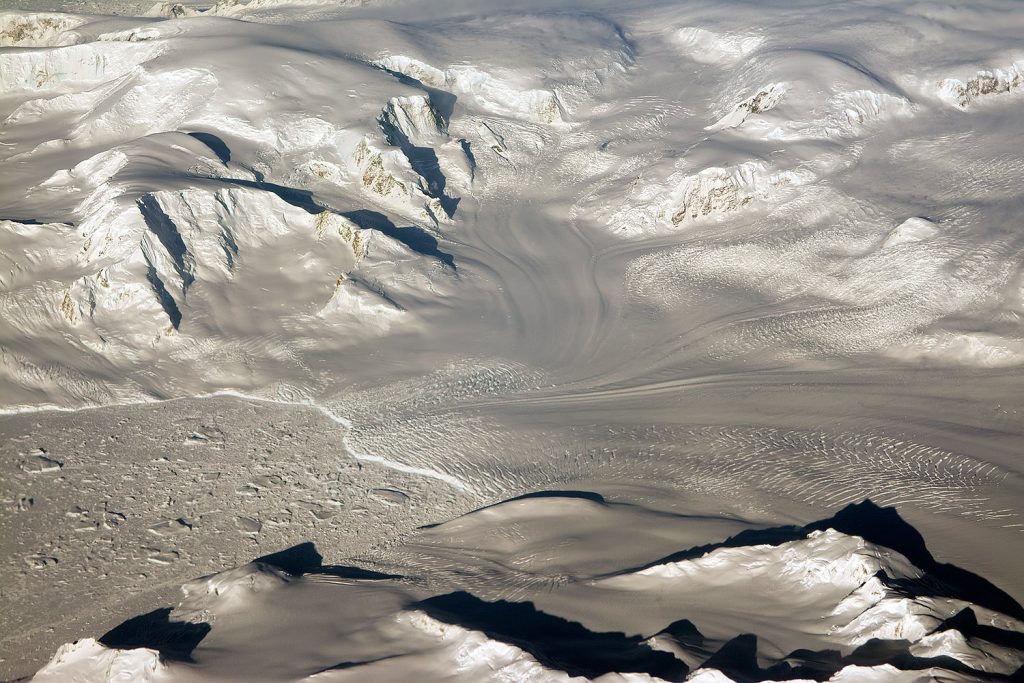Channels give warm ocean water access to their undersides, speeding glacier retreat
18 January 2017
WASHINGTON, DC—Glaciologists have uncovered large valleys in the ocean floor beneath some of the massive glaciers flowing into the Amundsen Sea in West Antarctica. Carved by earlier advances of ice during colder periods, the troughs enable warm, salty water to reach the undersides of glaciers, fueling their increasingly rapid retreat.

West Antarctica glaciers observed during an October 2014 NASA Operation IceBridge mission. New research shows valleys in the ocean floor enable warm, salty water to reach the undersides of glaciers, fueling their increasingly rapid retreat.
Credit:NASA / Michael Studinger.
“These oceanic features are several hundreds to a thousand meters deeper than what we thought before,” said Romain Millan, a graduate student in Earth system science at UCI and lead author of the new study. “It gives new insight into the future fate of these glaciers and the potential influence of warm ocean water that can melt away ice from below.”
The discovery is the result of an analysis of gravity data from airborne NASA Operation IceBridge missions from 2009 to 2014 combined with ice motion measurements made by researchers at the University of California, Irvine (UCI), UCI’s own mass conservation algorithm, and existing bed topography and ice thickness information. The new study has been accepted for publication in Geophysical Research Letters, a journal of the American Geophysical Union.
In the new study, the researchers paid particular attention to sub-ice-shelf cavities in front of the Pine Island, Thwaites, Smith and Kohler glaciers in an area known as the Amundsen Sea Embayment. By obtaining a more high-resolution map of the ocean floor below the glaciers, they were able to detect an unmistakable cavity beneath the Pine Island Glacier and a slightly shallower depression beneath Thwaites Glacier.
“Based on our research, we now have a much clearer picture of what is hiding under these large glaciers located in a particularly vulnerable sector of West Antarctica,” Millan said.
Millan said the study’s most important findings were the gigantic submarine valleys under the Crosson and Dotson ice shelves. The channels start 1,200 meters (3,900 feet) below the masses of ice and slope up to points 500 meters (1,600 feet) beneath Crosson and 750 meters (2,500 feet) beneath Dotson.
Should glaciers in the Amundsen Sea Embayment region of Antarctica completely collapse, the researchers said, the global sea level could rise an additional 1.2 meters (4 feet). As bad as that sounds, they noted, there are some features of the ocean floor topography that might work to slow down the process of glacier retreat.
“We find that the access of warm water to the glaciers and ice shelves in this region are almost controlled by a depth of about 700 meters [2,300 feet], which is just right above some of the warmest waters in the region,” said Eric Rignot, a professor of Earth system science at UCI and co-author of the new study. “This means that the glaciers are reassuringly not exposed to the warmest waters, but it makes projections more challenging because the pathways of the ocean heat are narrow and more sensitive to fluctuations.”
He said the findings will be instrumental in guiding future investigations of this region of Antarctica, in particular a major study of Thwaites Glacier by the National Science Foundation and the United Kingdom’s Natural Environment Research Council scheduled for 2018 to 2023.
###
The American Geophysical Union is dedicated to advancing the Earth and space sciences for the benefit of humanity through its scholarly publications, conferences, and outreach programs. AGU is a not-for-profit, professional, scientific organization representing 60,000 members in 137 countries. Join the conversation on Facebook, Twitter, YouTube, and our other social media channels.
Founded in 1965, the University of California, Irvine is the youngest member of the prestigious Association of American Universities. The campus has produced three Nobel laureates and is known for its academic achievement, premier research, innovation and anteater mascot. Led by Chancellor Howard Gillman, UCI has more than 30,000 students and offers 192 degree programs. It’s located in one of the world’s safest and most economically vibrant communities and is Orange County’s second-largest employer, contributing $5 billion annually to the local economy.
Notes for Journalists
This research article is open access for 30 days. A PDF copy of the article can be downloaded at the following link: http://onlinelibrary.wiley.com/doi/10.1002/2016GL072071/pdf.
After 30 days, journalists and public information officers (PIOs) of educational and scientific institutions who have registered with AGU can download a PDF copy of the article from the same link.
Journalists and PIOs may also order a copy of the final paper by emailing a request to Lauren Lipuma at [email protected].
Please provide your name, the name of your publication, and your phone number.
Neither the paper nor this press release is under embargo.
“Bathymetry of the Amundsen Sea Embayment sector of West Antarctica from Operation IceBridge gravity and other data”
Romain Millan, Vincent Bernier, Mathieu Morlighem: University of California Irvine, Department of Earth System Science, Irvine, California, U.S.A.;
Eric Rignot: University of California Irvine, Department of Earth System Science, Irvine, California, U.S.A., and NASA Jet Propulsion Laboratory/California Institute of Technology, Pasadena, California, U.S.A.;
Pierre Dutrieux: Lamont-Doherty Earth Observatory of Columbia University, Palisades, New York, U.S.A.
Contact information for the authors:
Romain Millan: [email protected]
Eric Rignot: +1 (949) 824-3739, [email protected]
Lauren Lipuma
+1 (202) 777-7396
[email protected]
University of California Irvine Contact:
Brian Bell
+1 (949) 824-8249
[email protected]